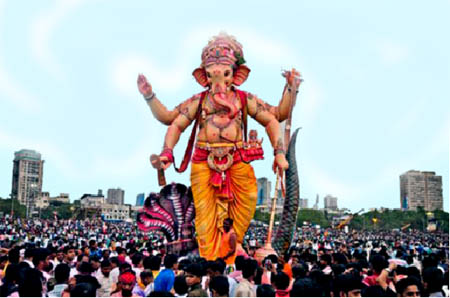Ganesh Chaturthi in the month of Bhadrapada is celebrated all over India, but in Maharashtra the zeal and splendour is unparalleled. Ganesh Chaturthi marks the birth of the God of Wisdom, Shri Ganesha. The history of these celebrations dates back to the era of Chhatrapati Shivaji, the founder of the Maratha Empire. Bhagwan Ganesh was the Kuldevata (Family God) of the Peshwas. Some historians are of the opinion that the earliest instances of Ganesh Chaturthi celebrations can be even traced back to the times of Satavahana, Rashtrakuta and Chalukya rules. Lokmanya Bal Gangadhar Tilak popularised Ganesh Chaturthi as a national festival in the late nineteenth century. He wanted to unite all Indians to fight together in the war of independence against the British.
Over the years, the form of celebrations has evolved and changed but the spirit has been constant. Now, thousands of Sarvajanik Pandals are made with crores of rupees, and the celebrations have become a gala annual affair. Temporary pandals are erected all over the cities and the idol of Shri Ganesh is installed in them on the Vinayak Chaturthi. The idol is worshipped for ten days and is immersed in the water on Ganesh Chaturthi. The spatial pattern of this phenomenon across the city is phenomenal.
Competitiveness of creativity and design innovation are for display everywhere. Integration of tradition, image of the deity, illumination and design, overall ambience, innovation in pandal design, addressing environmental issues, current social issues, crowd management and safety features, and many more complexities have evolved the event into multifold social activity having tremendous impact on social, economic and other aspects of the city life.
Though temporary, the spatial transformation of the city during these ten days is the unique feature of Indianness. Adjustment, accommodation, tolerance and bhakti are at exhibit. Ganesh Puja is not just passion but a manifestation of inclusive planning, collective innovation, and traditional design practices. The patterns of these temporary urban transformations are actually the repositories of qualities that illustrate how the Indian city is an alive and vibrant place to live in. These spaces are the forms of temporary temples of Bhagwan Ganesh.



















Comments